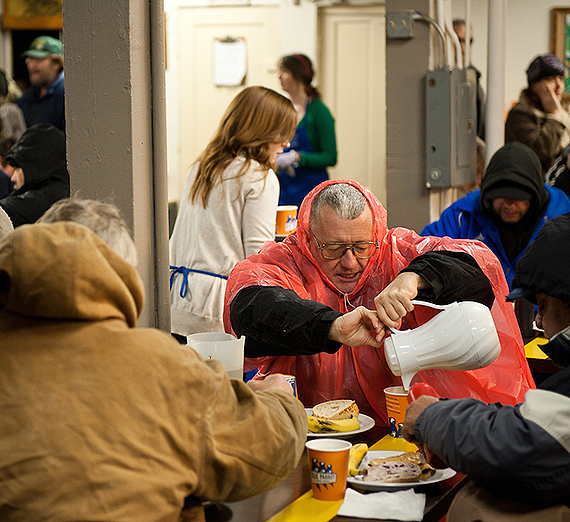Mission: Possible, Service Making a Difference

Gonzaga’s Center for Community Action and Service Learning coordinates Mission: Possible – Spring Break projects in various cities where students work with individuals from marginalized populations, including the homeless, incarcerated women with children, Native Americans, refugees from other countries and veterans. Mission: Possible is an immersive experience for students to gain insight into the lives of others who are facing adversity and is an opportunity to grow as an individual. Perhaps more significantly, the experience provides a deeper understanding and respect for the backgrounds of others, which has proven to be essential in the field of education. This year, Kathy Nitta, lecturer in Teacher Education and Dr. Heidi Nordstrom, assistant professor in Sport and Physical Education, served as advisors for two of the programs. The two advisors and their students share their experience.
Homelessness in Phoenix
Dr. Heidi Nordstrom,
assistant professor in Sport
and Physical Education
Advised students working with groups seeking transitional housing assistance.
We shared that we should not assume “why” there are homeless people and just accept the reality they are homeless. We do not know all of their stories and it shouldn’t matter the reason – we should just serve others and help where we can.
This is especially true with the veteran population. Some of the men and women were severely injured and not capable of living without assistance, while others suffered from post-traumatic stress disorder (PTSD), or were affected by other types of mental illness from the trauma experienced during conflict. We often forget how hard it can be to lose everything, especially for veterans who often return to the United States with little help and resources to transition back into everyday life.
Makah Tribe, Neah Bay, WA
Kathy Nitta, Lecturer in
Teacher Education
Kathy Nitta advised students working in schools on the reservation.
This trip to work among the Makah Tribe was incredibly eye-opening. What I learned as an advisor and a teacher educator is that we talk about drawing on individual cultural community, but the question really becomes, ‘How do we bring it into that context and use the Native American culture to inform the way we educate?’
I was expecting that I would learn a lot about a culture, but this experience afforded a great opportunity to get an in-depth perspective. I gained a deeper understanding of the struggles these children face and learned to see the inequities which exist in education for students with varied cultures.
Morgan Green, one of Kathy’s secondary education students, shared, “Our time in Neah Bay was a great view into culturally competent teaching, as the school so seamlessly integrated the culture of the outside community into their students’ education.”
She was very impressed by a group of students in a shop class at Neah Bay High School who were building canoes and paddles to use on their journeys in the summer. Her experience on the Makah reservation allowed Morgan to gain a better understanding of how each student carries his/her own personal background and narrative into the classroom, and how embracing a student’s culture enables him/her to thrive. Morgan said, “This cultural immersion experience was invaluable to my development as a future educator and allowed me to see new perspectives, and approaches that will mold my own personal philosophy.”
Homelessness in Phoenix
Dr. Heidi Nordstrom,
assistant professor in Sport
and Physical Education
Advised students working with groups seeking transitional housing assistance.
We shared that we should not assume “why” there are homeless people and just accept the reality they are homeless. We do not know all of their stories and it shouldn’t matter the reason – we should just serve others and help where we can.
This is especially true with the veteran population. Some of the men and women were severely injured and not capable of living without assistance, while others suffered from post-traumatic stress disorder (PTSD), or were affected by other types of mental illness from the trauma experienced during conflict. We often forget how hard it can be to lose everything, especially for veterans who often return to the United States with little help and resources to transition back into everyday life.
Makah Tribe, Neah Bay, WA
Kathy Nitta, Lecturer in
Teacher Education
Kathy Nitta advised students working in schools on the reservation.
This trip to work among the Makah Tribe was incredibly eye-opening. What I learned as an advisor and a teacher educator is that we talk about drawing on individual cultural community, but the question really becomes, ‘How do we bring it into that context and use the Native American culture to inform the way we educate?’
I was expecting that I would learn a lot about a culture, but this experience afforded a great opportunity to get an in-depth perspective. I gained a deeper understanding of the struggles these children face and learned to see the inequities which exist in education for students with varied cultures.
Morgan Green, one of Kathy’s secondary education students, shared, “Our time in Neah Bay was a great view into culturally competent teaching, as the school so seamlessly integrated the culture of the outside community into their students’ education.”
She was very impressed by a group of students in a shop class at Neah Bay High School who were building canoes and paddles to use on their journeys in the summer. Her experience on the Makah reservation allowed Morgan to gain a better understanding of how each student carries his/her own personal background and narrative into the classroom, and how embracing a student’s culture enables him/her to thrive. Morgan said, “This cultural immersion experience was invaluable to my development as a future educator and allowed me to see new perspectives, and approaches that will mold my own personal philosophy.”
